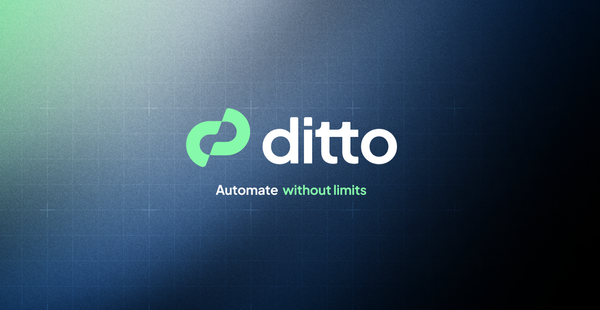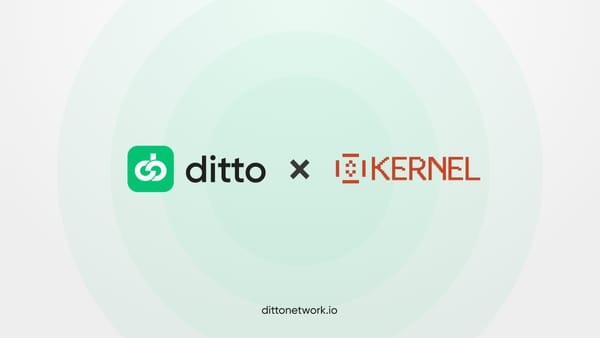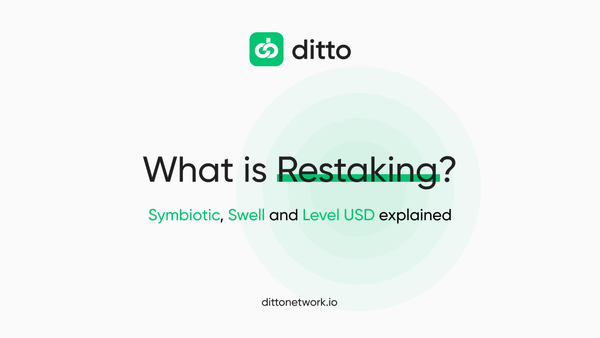Ditto Emergency Repayments: Automation for DeFi Protocols
Ditto Network's emergency repayment automation provides a scalable, secure, and efficient solution for DeFi protocols like Aave through Symbiotic and EigenLayer integration

You, the user, have 300 $ETH sitting in your wallet, and you're wondering how to make the most of it. We get it—so do we. DeFi offers numerous ways to utilize your tokens for additional yield, but with great opportunities come significant risks. One critical aspect of managing these opportunities? Emergency repayments.
Let’s dive into how Ditto Network makes DeFi smarter, safer, and more efficient.
As DeFi grows, the need for automation for developers and protocols becomes increasingly crucial. Ditto Network's emergency repayment automation provides a scalable, secure, and efficient solution for DeFi protocols like Aave, leveraging innovations such as shared security through Symbiotic and EigenLayer integration and smart contract automation to transform how decentralized applications operate.
How Borrow-Lend Pools Work in DeFi
Borrow-lend pools serve as the backbone of many DeFi platforms, enabling users to:
- > Deposit digital assets as collateral.
- > Borrow against these assets.
- > Earn interest on deposits or loans.
Example:
You lend your 300 $ETH to a protocol like Aave and borrow $EIGEN tokens instead, intending to use them for a new DeFi opportunity. You don’t want to sell your ETH—you just want it to stay there while you make additional gains. However, the borrowed assets and market fluctuations require constant monitoring, as your position is at risk of liquidation if not managed correctly.
How Does Aave Work?
Aave allows users to:
- > Supply liquidity to earn yield.
- > Borrow funds against their collateral.
Example:
In our $ETH/$EIGEN example, Aave manages your collateral and loan, while continuously tracking the "health factor" of your position. If the market swings against you, Aave's mechanisms will flag your account as potentially under-collateralized.
What Is an Automated Market Maker (AMM)?
Automated Market Makers (AMMs) power decentralized exchanges by replacing traditional order books with liquidity pools. Liquidity providers (LPs) deposit assets into these pools, enabling seamless and trustless asset exchanges.
Example:
If you use $EIGEN tokens borrowed from Aave to participate in an AMM pool on Uniswap, you earn trading fees while increasing liquidity in the ecosystem. However, if your health factor in Aave deteriorates, your position will be liquidated with premium - this is where Ditto's automation ensures you're always protected.
Understanding Collateral and Health Factors in Aave
Collateral represents assets pledged by borrowers to secure a loan. The health factor in Aave measures the safety of a position, calculated as a ratio of collateral value to borrowed value. A health factor above 1 is safe, while a value below 1 means your position is at risk of liquidation.
Example:
As the market fluctuates, your $ETH collateral value decreases, dropping your health factor below 1. This triggers liquidation processes that could result in significant penalties unless mitigated promptly.
What Is a Flash Loan in Aave?
Flash loans are uncollateralized loans that must be repaid within the same transaction. These are popular in DeFi for arbitrage and collateral swaps and play a vital role in emergency repayments.
Example:
Ditto leverages flash loans to restore your health factor by borrowing funds temporarily, repaying your $EIGEN loan, and avoiding liquidation penalties.
How Ditto Solves Emergency Repayment Challenges
Ditto Network automates emergency repayments for DeFi protocols, minimizing liquidation risks through real-time monitoring, automation, and smart contract integration.
Automation Strategy:
- 1. Real-Time Health Factor Monitoring: Ditto tracks health factors continuously, detecting risky positions early and preventing liquidation.
- 2. Flash Loan-Enabled Repayment: Ditto executes flash loans to restore the health factor instantly.
- 3. Mitigating Liquidation Penalties: Ditto's automation ensures timely repayment, saving users from costly penalties.
- 4. Redistribution of Remaining Assets: Any remaining collateral is returned to the liquidity pool, ensuring capital efficiency.
The Role of EigenLayer Integration in Automation
Ditto’s integration with EigenLayer enhances automation reliability through shared security and economic guarantees.
Benefits:
- > Economic Guarantees: Executors are incentivized to perform tasks accurately, backed by EigenLayer's slashing mechanisms.
- > Cross-Network Trust: Ditto ensures that actions taken on different blockchains are secure and synchronized.
Why Choose Ditto for Emergency Repayments?
Problem: Risk of Liquidation
Unmanaged positions lead to liquidation and penalties.
Ditto Solution: Real-time health factor monitoring and automated repayments prevent liquidation.
Problem: Manual Interventions
Users or developers spend excessive time managing positions.
Ditto Solution: Automation handles everything from monitoring to repayments, saving time and resources.
Conclusion: Scaling DeFi with Ditto Network
As DeFi and dApps growth continue to reshape blockchain, tools like Ditto Network are critical for maintaining the reliability and efficiency of protocols.
By automating emergency repayments, Ditto enables developers to create scalable decentralized applications that deliver enhanced user experiences and economic efficiency.
Whether you’re a DeFi protocol looking to streamline operations or a developer building innovative solutions, Ditto’s automation tools, backed by Symbiotic and EigenLayer integration, are your gateway to the next generation of blockchain infrastructure.
Contact us today to learn how Ditto can transform your protocol.




